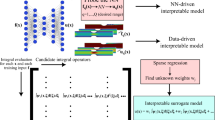Abstract
Use of machine learning (ML) to solve partial differential equations (PDEs) is a growing area of research. In this work we apply ML to accelerate a numerical discretization scheme: the radial basis function time domain (RBF-TD) method. The RBF-TD method uses scattered nodes in both space and time to time-step PDEs. Here we investigate replacing a costly L1 minimization step in the original RBF-TD method with an ensemble ML model known as an extremely randomized trees regressor (ERT). We show that an ERT model trained on a simple PDE can maintain the high order accuracy of the original method with often significant speed up, while generalizing to a variety of convection-dominated PDEs. Through this work, we also extend the RBF-TD method to problems in 2-D space plus time. This study illustrates a novel opportunity to use ML to augment finite difference-related approximations while maintaining high order convergence under node refinement.










Similar content being viewed by others
Data Availability
The code and models are written in a combination of Matlab and Python and are available upon reasonable request addressed to the corresponding author.
References
Abrahamsen, D., Fornberg, B.: Explicit time stepping of PDEs with local refinement in space-time. J. Sci. Comput. 81(3), 1945–1962 (2019). https://doi.org/10.1007/s10915-019-01065-3
Bayona, V., Flyer, N., Fornberg, B.: On the role of polynomials in RBF-FD approximations: III. Behavior near domain boundaries. J. Comput. Phys. 380, 378–399 (2019). https://doi.org/10.1016/j.jcp.2018.12.013
Bayona, V., Flyer, N., Fornberg, B., Barnett, G.A.: On the role of polynomials in RBF-FD approximations: II. Numerical solution of elliptic PDEs. J. Comput. Phys. 332, 257–273 (2017). https://doi.org/10.1016/j.jcp.2016.12.008
Beck, A.D., Zeifang, J., Schwarz, A., Flad, D.G.: A neural network based shock detection and localization approach for discontinuous Galerkin methods. J. Comput. Phys. 423, 109824 (2020). https://doi.org/10.1016/j.jcp.2020.109824
Flyer, N., Barnett, G., Wicker, L.: Enhancing finite differences with radial basis functions: experiments on the Navier–Stokes equations. J. Comput. Phys. 316, 39–62 (2016)
Flyer, N., Fornberg, B., Bayona, V., Barnett, G.A.: On the role of polynomials in RBF-FD approximations: I. Interpolation and accuracy. J. Comput. Phys. 321, 21–38 (2016). https://doi.org/10.1016/j.jcp.2016.05.026
Fornberg, B., Flyer, N.: Fast generation of 2-D node distributions for mesh-free PDE discretizations. Comput. Math. Appl. 7, 531–544 (2015). https://doi.org/10.1016/j.camwa.2015.01.009
Fornberg, B., Flyer, N.: A primer on radial basis functions with applications to the geosciences. Soc. Ind. Appl. Math. (2015)
Geurts, P., Ernst, D., Wehenkel, L.: Extremely randomized trees. Mach. Learn. 63(1), 3–42 (2006)
Hsieh, J., Zhao, S., Eismann, S., Mirabella, L., Ermon, S.: Learning neural PDE solvers with convergence guarantees. In: International Conference on Learning Representations (2019). https://openreview.net/forum?id=rklaWn0qK7
Huang, B., Boutros, P.: The parameter sensitivity of random forests. BMC Bioinf. (2016). https://doi.org/10.1186/s12859-016-1228-x
Kossaczká, T., Ehrhardt, M., Günther, M.: Enhanced fifth order WENO shock-capturing schemes with deep learning. arXiv:2103.04988 [physics] (2021)
Lagaris, I.E., Likas, A., Fotiadis, D.I.: Artificial neural networks for solving ordinary and partial differential equations. IEEE Trans. Neural Netw. 9(5), 987–1000 (1998)
Lagaris, I.E., Likas, A.C., Papageorgiou, D.G.: Neural-network methods for boundary value problems with irregular boundaries. IEEE Trans. Neural Netw. 11(5), 1041–1049 (2000)
Li, Z., Kovachki, N., Azizzadenesheli, K., Liu, B., Bhattacharya, K., Stuart, A., Anandkumar, A.: Fourier neural operator for parametric partial differential equations. arXiv:2010.08895 [cs, math] (2021)
Long, Z., Lu, Y., Ma, X., Dong, B.: PDE-Net: Learning PDEs from data. In: Proceedings of the 35th International Conference on Machine Learning, pp. 3208–3216. PMLR (2018)
Lu, L., Jin, P., Karniadakis, G.: DeepONet: Learning nonlinear operators for identifying differential equations based on the universal approximation theorem of operators. arXiv:1910.03193 [cs, stat] (2020)
Pedregosa, F., Varoquaux, G., Gramfort, A., Michel, V., Thirion, B., Grisel, O., Blondel, M., Prettenhofer, P., Weiss, R., Dubourg, V., Vanderplas, J., Passos, A., Cournapeau, D., Brucher, M., Perrot, M., Duchesnay, E.: Scikit-learn: machine learning in python. J. Mach. Learn. Res. 12, 2825–2830 (2011)
Psichogios, D., Ungar, L.: A hybrid neural network-first principles approach to process modeling. AIChE J. 38(10), 1499–1511 (1992)
Raissi, M., Karniadakis, G.: Hidden physics models: machine learning of nonlinear partial differential equations. J. Comput. Phys. 357, 125–141 (2018). https://doi.org/10.1016/j.jcp.2017.11.039
Raissi, M., Perdikaris, P., Karniadakis, G.: Machine learning of linear differential equations using gaussian processes. J. Comput. Phys. 348, 683–693 (2017). https://doi.org/10.1016/j.jcp.2017.07.050
Raissi, M., Perdikaris, P., Karniadakis, G.: Physics-informed neural networks: a deep learning framework for solving forward and inverse problems involving nonlinear partial differential equations. J. Comput. Phys. 378, 686–707 (2019). https://doi.org/10.1016/j.jcp.2018.10.045
Slak, J., Kosec, G.: On generation of node distributions for meshless pde discretizations. SIAM J. Sci. Comput. 41(5), A3202–A3229 (2019)
Stevens, B., Colonius, T.: Enhancement of shock-capturing methods via machine learning. Theoret. Comput. Fluid Dyn. 34(4), 483–496 (2020). https://doi.org/10.1007/s00162-020-00531-1
van der Sande, K., Fornberg, B.: Fast variable density 3-D node generation. SIAM J. Sci. Comput. 43(1), A242–A257 (2021)
Funding
The authors declare that no funds, grants, or other support were received during the preparation of this manuscript.
Author information
Authors and Affiliations
Corresponding author
Ethics declarations
Conflict of interest
The authors have no relevant financial or non-financial interests to disclose.
Additional information
Publisher's Note
Springer Nature remains neutral with regard to jurisdictional claims in published maps and institutional affiliations.
Rights and permissions
Springer Nature or its licensor (e.g. a society or other partner) holds exclusive rights to this article under a publishing agreement with the author(s) or other rightsholder(s); author self-archiving of the accepted manuscript version of this article is solely governed by the terms of such publishing agreement and applicable law.
About this article
Cite this article
van der Sande, K., Flyer, N. & Fornberg, B. Accelerating Explicit Time-Stepping with Spatially Variable Time Steps Through Machine Learning. J Sci Comput 96, 31 (2023). https://doi.org/10.1007/s10915-023-02260-z
Received:
Revised:
Accepted:
Published:
DOI: https://doi.org/10.1007/s10915-023-02260-z




